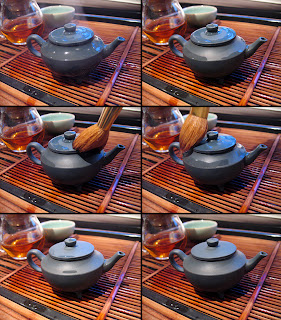
Brushing is important only when using a flat top or larger lid pot. Since the water/tea will not evaporate as fast on a leveled surface, spreading the liquid all around with brush will speed up the "drying" action.
Pot craftsman might scarify the function with overall beauty, so we have to learn the behavior of each collectable.
Some tricks may apply to the practices, eg.
1. Angling the lid and pouring water onto it:
This method of pouring will heat up the lid more and cool the water temp. Meanwhile, extra water will accumulate less on the surface. For puerh or aged oolong brewing, this "delicate pouring" will soften the property of the liquor, since hot water will not hit/attack the leaves directly (it really makes a different). This pouring method is prefer by seasoned tea drinker.
2. Simply pour the liquor out 90 degree, and all liquid inside-out will drip dry.
No matter how good you master the brushing of the top, bottom area will always be troubling. Like this rounded bottom fellow (pic. below), you can see the darken circle tea spot at the center. The only way is to polish after usage and let dry.








1 comment:
Wow I didn't realize you had more pots made from Mou LvNi. I have recently heard people iin yixing calling that light blue clay as Wen Ge LvNi and another very similar clay Tian Qing LvNi. Have you heard these names?
Post a Comment